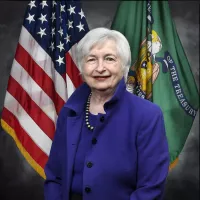The American Rescue Plan Act of 2021, a $1.9 trillion economic stimulus bill, was signed into law by President Joe Biden on March 11, 2021. It aims to accelerate the United States' recovery from the economic and health crises caused by the COVID-19 pandemic. Building on the CARES Act and the Consolidated Appropriations Act, 2021, the plan includes provisions for direct payments to individuals, expanded unemployment benefits, aid to state and local governments, funding for COVID-19 testing and vaccine distribution, and support for schools and childcare. The act addresses various issues exacerbated by the pandemic, seeking to stabilize the economy and provide relief to households and businesses.
2001: Firing of Robert Dove
In 2001, Republicans fired Robert Dove after he made a series of rulings blocking tax cuts from being considered under the 51-vote budget reconciliation process. This is in reference to progressive democrats and liberal groups urging Harris to overrule MacDonough.
March 2020: CARES Act
In March 2020, The CARES Act was passed and the American Rescue Plan builds upon many of the measures in it.
May 2020: House voted on the HEROES Act
In May 2020, The House voted on the HEROES Act in May 2020, which would operate as a $3 trillion relief package.
November 2020: 2020 election
Republicans in Congress claimed the American Rescue Plan bill only benefitted Democratic-led states, states that voted for Biden in November 2020.
December 2020: Consolidated Appropriations Act signed into law
In December 2020, then-president Donald Trump signed the Consolidated Appropriations Act into law.
2020: Economic recession
By mid-2020, the United States was facing an economic recession, as determined by the National Bureau of Economic Research.
2020: CARES Act
In March 2022 a study mentioned the 2020 CARES Act as one of the US fiscal support measures.
January 14, 2021: American Rescue Plan proposed
On January 14, 2021, the American Rescue Plan was first proposed as a US$1.9 trillion economic stimulus bill.
January 2021: Eviction risk
In January 2021, over 30 to 40 million Americans faced a risk of being evicted from their homes.
February 8, 2021: Draft of stimulus legislation released
On February 8, 2021, the Financial Services and Education and Labor committees released a draft of $1.9 trillion stimulus legislation.
February 2021: COVID-19 deaths reach 500,000
By February 2021, the United States had reached 500,000 deaths due to COVID-19.
February 2021: CBO analysis on minimum wage increase
In February 2021, the Congressional Budget Office released a budget analysis that found that increasing the minimum wage to $15 would lift 900,000 people out of poverty and cumulatively raise the wage of all affected people by $333 billion, but also could increase the cumulative budget deficit and reduce employment.
February 2021: Biden criticized Republicans
In early February 2021, President Joe Biden criticized Republicans for not seeking a bipartisan compromise on a final aid bill, signaling openness to passing the legislation without Republican support.
March 10, 2021: House passes Senate bill
On March 10, 2021, the House passed the Senate bill on a near party-line vote, sending it to President Biden for his signature.
March 11, 2021: American Rescue Plan signed into law
On March 11, 2021, President Joe Biden signed the American Rescue Plan Act of 2021 into law, a $1.9 trillion economic stimulus bill aimed at speeding up the country's recovery from the COVID-19 pandemic and recession.
March 15, 2021: Gene Sperling to oversee implementation
On March 15, 2021, the White House announced that Gene Sperling will oversee the implementation of the American Rescue Plan.
2021: Inflation effects
A March 2022 study estimated that U.S. fiscal support measures may have raised core inflation about 3 percentage points by the end of 2021.
2021: American Rescue Plan Act provisions
In 2021, The American Rescue Plan Act provided direct economic stimulus payments to individual taxpayers, allocated assistance to state and local governments, funded COVID-19 vaccine distribution and school reopening, extended unemployment benefits, expanded the child tax credit, provided relief for small businesses and restaurants, expanded Affordable Care Act subsidies, and gave states incentives to expand Medicaid.
2021: Biden announces the $1.9 trillion stimulus package
On January 14, 2021, prior to being inaugurated as president, Biden announced the $1.9 trillion stimulus package.
March 2022: Study on inflation effects
A March 2022 study released by the Federal Reserve Bank of San Francisco estimated that U.S. fiscal support measures may have raised core inflation about 3 percentage points by the end of 2021.
2022: Brookings Institution Study
A 2022 study from the Brookings Institution found mixed results for some of the bill's economic development funding.
2022: Section 1005 payments halted
In 2022, Preliminary injunctions issued in federal district court cases halted section 1005 payments, which related to socially disadvantaged farmers and ranchers.
2022: Yellen predicted full employment
In February 2021, Treasury Secretary Janet Yellen said that the stimulus package would restore full employment by 2022.
2025: Romney and Cotton's bill on minimum wage
Republican Senators Mitt Romney and Tom Cotton introduced their own bill, which would raise the minimum wage to $10, phasing in gradually to 2025.
Mentioned in this timeline

Joe Biden a member of the Democratic Party served as...

San Francisco is a major commercial financial and cultural hub...

Inflation in economics signifies an increase in the average price...
Medicaid is a joint federal and state government program providing...

Janet Louise Yellen is a prominent American economist with a...

A minimum wage is the legally mandated lowest amount employers...
Trending
Mike Elko is an American college football coach currently serving as the head coach at Texas A M University a...

7 months ago Yankees' Luke Weaver Likely to Injured List Due to Hamstring Issue
7 months ago Cade Horton promoted to Chicago Cubs; Mets prepare for Horton debut.

2 months ago Learner Tien faces Nuno Borges in ATP Paris Masters 2025 first round.

Fani Taifa Willis is an American attorney currently serving as the district attorney of Fulton County Georgia since Notably she...

Matthew Judon is an American football linebacker for the Atlanta Falcons He played college football at Grand Valley State setting...
Popular

Candace Owens is an American conservative political commentator and author...

Ilhan Omar is an American politician currently serving as the...

XXXTentacion born Jahseh Dwayne Ricardo Onfroy was a controversial yet...

Charles James Charlie Kirk was a prominent American right-wing political...

Frederick Christ Trump Sr - was an American real estate...

Bill Gates an American businessman and philanthropist revolutionized personal computing...